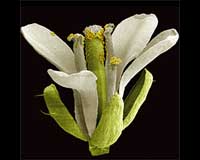 |
Blacksburg VA (SPX) Nov 16, 2010 Many plants, including crops, release volatiles in response to insect attack. The chemical compounds can be a defense or can be an aromatic call for help to attract enemies of the attacking insect. Researchers from Virginia Tech, Michigan State University, and Georg-August-University Gottingen have discovered how plants produce the defensive compounds. To gain detailed insight into volatile defense metabolism and its regulation in plant tissues, the researchers focused on the formation of two common volatile compounds, or homoterpenes - DMNT (4,8-dimethylnona-1,3,7-triene) and TMTT (4,8,12-trimethyltrideca-1,3,7,11-tetraene). They discovered that formation of both compounds is initiated by the same P450 enzyme - belonging to a family of enzymes that initiates oxidation of organic compounds in most plants, animals, and bacteria. In plants, the enzyme is specifically activated by insect attack. "We are excited to finally have elucidated the biosynthesis of these common plant volatiles. The discovered P450 protein was a long-missing enzymatic link in the formation of homoterpenes," said Tholl. Lee and colleagues created a model using mammalian forms of P450 to study the catalytic specificity of the plant enzyme in greater detail. "The approach supports future efforts to fully understand and optimize the enzymatic reaction," said Tholl. "A primary aim of the study is to engineer the discovered enzymatic pathway in important crop plants to improve their natural pest controls." "This work illustrates the power of combining computational model-building with experimental methods in elucidating important biochemical activities," said Bevan. "Our detailed understanding of the biology underlying the production of these plant volatiles will now enable us to apply our new knowledge in agriculture in novel ways." "We now are in the position to use this and previously identified genes of the biosynthetic pathway as tools to change volatile profiles in plants," said Tholl. "This approach can help us to design insect-induced volatile mixtures that are especially attractive to natural enemies used in biological pest control." Another intriguing aspect of homoterpene volatiles is that they can elicit defensive responses in unattacked neighboring plants. "It may therefore be possible to exploit these signaling activities by priming defenses in crop fields prior to insect attack via specific transgenic 'emitter' plants," Tholl said. The research is reported this week in the online early edition of the Proceedings of the National Academy of Sciences. The article, "Herbivore-induced and floral homoterpene volatiles are biosynthesized by a single P450 enzyme (CYP82G1) in Arabidopsis," is by Sungbeom Lee, postdoctoral associate in biological sciences; Somayesadat Badieyan, Ph.D. student in biological systems engineering; and David R. Bevan, associate professor of biochemistry, all at Virginia Tech; Marco Herde, postdoctoral associate with the Michigan State University, Department of Biochemistry and Molecular Biology; Christiane Gatz, professor and head of the Albrecht-von-Haller-Institute for Plant Sciences at Georg-August-University Gottingen, Germany, and Dorothea Tholl, assistant professor of biological sciences at Virginia Tech.
Share This Article With Planet Earth
Related Links Virginia Tech Farming Today - Suppliers and Technology
 Change In Temperature Uncovers Genetic Cross Talk In Plant Immunity
Change In Temperature Uncovers Genetic Cross Talk In Plant ImmunityColumbia MO (SPX) Nov 16, 2010 Like us, plants rely on an immune system to fight off disease. Proteins that scout out malicious bacterial invaders in the cell and communicate their presence to the nucleus are important weapons in the plant's disease resistance strategy. Researchers at the University of Missouri recently "tapped" into two proteins' communications with the nucleus and discovered a previously unknown level ... read more |
|
| The content herein, unless otherwise known to be public domain, are Copyright 1995-2010 - SpaceDaily. AFP and UPI Wire Stories are copyright Agence France-Presse and United Press International. ESA Portal Reports are copyright European Space Agency. All NASA sourced material is public domain. Additional copyrights may apply in whole or part to other bona fide parties. Advertising does not imply endorsement,agreement or approval of any opinions, statements or information provided by SpaceDaily on any Web page published or hosted by SpaceDaily. Privacy Statement |